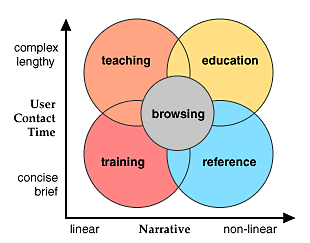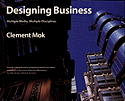Contents
Philosophy
|
Introduction Purpose of your site Design strategies |
All presentations of information are governed by a few parameters determined by your objectives, the practical logistics of the medium you chose, and by the nature of your audience. The graphic below plots four major themes for intranet information delivery against two fundamental variables: how linear the structure of your presentation will be, and how long the typical user contact time will be:

In the larger World Wide Web browsers ("Web surfers") are the unmotivated readers who may blow through your home page without an urgent mission or purpose in mind. Techniques for drawing these potential customers into a sales or entertainment site are beyond the scope of this manual, but you may find some guidance from these sources. The following categories of Web use are more typical of corporate and educational "intranet" sites where the users arrive with a more defined purpose.
Training
Web-based training applications tend to be very linear in design, and present few opportunities to digress from the central flow of the presentation. Don't confuse users or confound your own expectations by offering many links away from the central message. Restricting the links to "Next" and "Previous" paging functions guarantees that everyone sees the same presentation, and allows you to make more accurate predictions of user contact time. Most training presentations assume a contact time of less than one hour, or are broken up into sessions of an hour or less. Inform your users about how long the session will last, and warn them not to digress away from the required material if they are to get credit for the training. Training applications typically require a user log-in, and often present forms-based quiz questions in true/false or multiple-choice formats. User log information and scores are typically stored in a database linked to the Web site.
Teaching
Good teaching applications are also built around a strong central narrative, but typically offer more opportunities for students to pursue interesting digressions from the main themes of the Web site. The information presented is usually more sophisticated and in-depth than in training applications. Links are the most powerful aspect of the Web, but they can also be a distraction that may prevent your students getting through the basic presentation. If you want to provide students with links to other Web-based resources beyond your local site you might consider grouping the links on a page separate away from the main body of the material. Often users will want to print the material from the Web and read it later from paper. Make this easy for them by providing a "printing" version that consolidates many separate pages into one long page.
Education
The audiences for heuristic, self-directed learning will chafe at design strategies that are too restrictive and linear. Often the typical user is already highly educated. Flexible, interactive, non-linear design structures are ideal for these users, because it is so difficult to predict exactly what topics will most interest an experienced professional or graduate student. The design must allow fast access to a wide range of topics, and is typically very dense with links to related material within the local Web site and beyond on the World Wide Web. Text-based lists of links work well here for tables of contents and indexes because they load fast and are dense with information, but this audience is also easily bored and needs the frequent stimulation of well-designed graphics and illustrations to stay involved with the material. Contact times are unpredictable, but will often be shorter than for training or education sites because the users are usually under time pressure. Easy printing options are also a must for this audience.
Reference
The best-designed reference Web sites allow users to quickly pop into the site, find what they want, and then easily print or download what they find. Typically there is no "story" to tell, so the usage patterns are totally non-linear. Content and menu structure must be carefully organized to support fast search and retrieval, easy downloading of files, and convenient printing options. Keep the graphics minimal to speed download times, and you may want to investigate search software instead of relying exclusively on index-like lists of links. Contact time is typically brief, the shorter the better.

Mok, C. 1996. Designing business: multiple media, multiple disciplines. San Jose: Adobe Press. Netscape Authoring Resources (get authoring resources URL) Siegel, D. 1996. Creating killer web sites. Indianapolis: Hayden Books. www.killersites.com Studio Archetype |